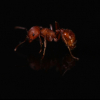When I was younger I tried this twice in a somewhat disorganized fashion. I would not recommend it unless you're planning to spend an entire day doing only that. It requires a commitment of the entire day and a lot of physical labor and then you still may not be successful.
The first time I tried this was in mid spring when I was 13 and ended up digging 5 feet down under the mound (and it was not a large one) and was still finding ants. It was too early and they were still hibernating, and I have no idea how far down the colony went but the point is that even if you dig one up mid summer if you're not fast to very quickly dig the entirety of the upper structure the queens could easily retreat to those depths before you can catch them. And you won't know if you have them because usually there's too many ants and debris everywhere to sort it by yourself at the scene, so plan on spending time afterwards doing so.
I tried again in my later teens and though I planned ahead and brought multiple large 5 gallon buckets to be escape proof, shoveled quickly and got the entire super structure in less than 30 seconds (and it was a much smaller colony), I still failed. A problem I had was that the colony happened to have thousands of alates whose wings fell off very easily. So as I was sorting the ants from the debris later that afternoon I had hundreds and hundreds of dealates mixed in with the workers and scattered wing fragments everywhere. This made finding the actual queen/queens impossible and though I kept the colony (in a very large dry aquarium) fed and watered no brood ever appeared. I think I likely got the queen/queens though I do not know why they did not start to lay eggs. If I'd had a better sorting method than just manually sorting from the debris in a large basin, I might have been more successful.
I would really not recommend it unless you're extremely committed, in which case I think it's probably better to just try to get some new queens after flights and boost them with pupae that is easily available from ripping a small hole in one of the larger nests. The donor colony will recover without much damage, and you won't have caused a massive hole in the local ecology. The other thing is that, someone correct me if I'm wrong, but I do not believe that all species of mound building Formica ants have multiple queens. You could be digging up a colony with only one queen, in which case it won't suffice to simply get a good portion of the colony and therefor probably a few queens as would be the case with a polygynous species.
Some tips if you absolutely insist on it:
The Formic Acid is real! I've never had burns like that fellow mentioned above, but I have gotten a bit whoosey and a severe headache from observing a colony too closely. I don't have even the slightest sense of smell, so often the only time I notice there is something wrong is when physical effects make themselves apparent. I also remember reading that if you do try to capture a large colony of these ants, make sure the buckets are not sealed so the ants don't gas themselves to death. This means prepping multiple buckets (preferably 5 gallon size) with fluon or similar, or replacing the lids with wire mesh (maybe both). Make sure not to pour too much colony debris into each bucket so as not to crush the ants. It would also be good to find a colony near the road so that you can load the buckets directly rather than carrying multiple heavy buckets through the woods.
There was a technique I heard of a long time ago that might be worth trying first as it's non-destructive. The technique was as such: In the morning during the dry part of the summer, take a 5 gallon bucket and fill to the bring with water. Pour bucket directly on top of the mound. Set bucket on top of the mound. The colony would then supposedly move up into the space under the bucket on the surface of the mound, easy to scoop up at this point. No idea if it's true, but you might try it. I think I might try it myself even.....
![]() One good thing is they don't sting, but still...I don't want to be bit or sprayed and they can probably bite pretty good.
One good thing is they don't sting, but still...I don't want to be bit or sprayed and they can probably bite pretty good. ![]()




















